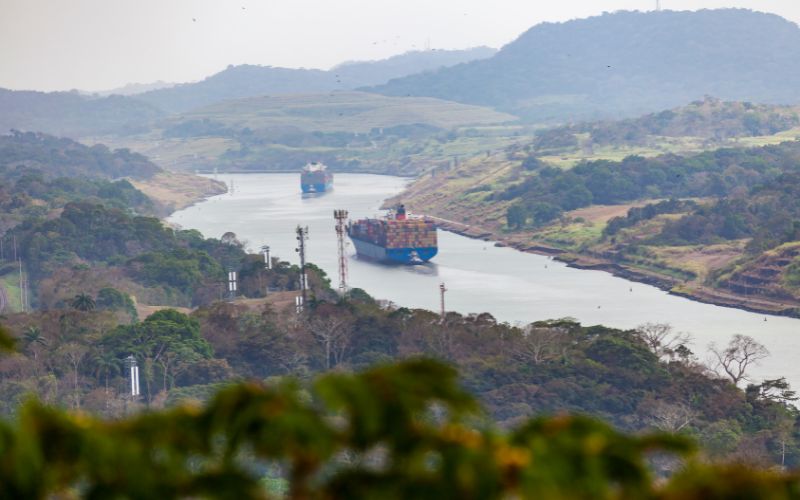Sea Lines of Communication are major maritime routes between ports around the world and are used for trade, military/naval, logistics and other purposes.
SLOCs, or Sea Lines of Communication, function as commercial trade routes in peacetime, but during wartime, they acquire a strategic place. The party that controls them has the upper hand, as seen in many historic naval battles.
SLOCs are also strategic waterways vital for nations to access resources in faraway regions. Hence, protecting the sea lines of communication becomes essential for the free flow of global maritime trade.
Importance of Sea Lines of Communication (SLOCs)
SLOCs are primary maritime trade lanes, often referred to as the arteries of a region’s economy. They promote economic development, sustain international trade, and act as crucial paths during wars or other emergencies.
When SLOCs are secure, maritime trade flourishes. The volume of seaborne trade in 2021 stood at 11 billion tonnes, a 3.2% increase from 2020.
The volume of maritime trade has almost doubled since the 1990s, when it was approximately four billion tonnes. The capacity of the global merchant fleet has also risen by over 40% between 2013 and 2021, reaching 2.1 million deadweight tonnes in 2021.
Protecting Sea Lines of Communication
The naval concept applicable to protecting SLOCs and maritime chokepoints is called sea control.
In the same way, maritime chokepoints are constricted yet heavily trafficked waterways separating oceans and seas. Due to security threats like pirates, they can be vulnerable to attacks or dangerous to navigate in some regions.
Lawful sea control helps deny or limit the enemy’s capacity to threaten SLOCs and chokepoints or use them for war-supporting shipping.
It also allows states to protect their navigational rights and prevent unlawful interference. Protecting SLOCs and chokepoints ensures that waterways remain open for trade and navigation but shielded from hostilities by enemies.
SLOCs and Geography
SLOCs can also be considered maritime routes taken by a ship to transit from Point A to B. This route should be short, safe, and economical for shipping cargo.
SLOCs have different lengths, depending on the landmass, choke points, reefs, and port and harbour locations.
There is a link between SLOCs and the geography of a region when making a strategy. Economists and the Military focus on geography while devising strategic relations and requirements.
For an Economist, the shortest distance, low cost of transportation and timely cargo delivery are essential factors in developing a maritime economic strategy.
When the military studies the SLOCs, geography is the major focus regarding the deployment of forces. It considers the positions of allies and enemies and the terrain that one must cross to get the help of the other.
A Few Important SLOCs
Several significant SLOCs and maritime chokepoints lie in the Indian Ocean, and a massive volume of international seaborne trade from the Persian Gulf region, Europe, and Africa passes through this ocean. This trade, especially of oil, impacts every aspect of people’s everyday lives worldwide.
Maritime chokepoints are narrow passages within the SLOCs, and a few of them in Southeast Asia, like Lombok, Sunda, and Malacca Straits, are important for the economic development of the Asia-Pacific.
More than one-third of the world’s cargo ships sail through these chokepoints. Ship traffic through the Malacca Strait is much higher than the traffic through the Panama or the Suez Canal.

The shipping routes or SLOCs that pass through the Indian Ocean and enter Southeast Asia are of great geostrategic importance to the U.S., Japan, Korea, China, and Taiwan.
India is located halfway between the Strait of Malacca and the Hormuz Strait. While there are alternative routes to the Malacca Strait, there are no other routes to transport Arabian Gulf oil except through land pipelines.
Hence, any contingencies in Hormuz Strait can impact the region. Indian Peninsula dominates the Sea Lines of Communication from the Persian Gulf before they round off south of Dundra Head in Sri Lanka.
Also, these SLOCs pass near the Andaman and Nicobar Islands before they enter the Malacca Strait. The commercial ship traffic passing through Malacca Strait goes from near the Indian region of maritime interest and so any contingencies or security issues in the strait places responsibility on India for preserving order at sea.
Threats to Sea Lines of Communication
Pirate Attacks
Southeast Asia is a piracy hotspot and witnesses many incidents throughout the year, especially in the Malacca and Singapore Straits. These waterways witness the heaviest maritime traffic congestion, and hundreds of ships transit them annually.
VLCCs reduce speed while crossing the waterways as the presence of shallow areas and shipwrecks makes them dangerous to navigate. Pirates target ships in this region as they can get away quickly due to the geography, leading to a rise in piracy attacks, which are becoming common in the Arabian Sea and the Bay of Bengal.

Seafarers are often left traumatised after such attacks on ships, which lead to violence, abductions, harassment or even killings and torture.
In 2022, 58 piracy attacks were recorded in Southeast Asian waters. In the first part of 2023, 41 such attacks were reported in the Malacca and Singapore Straits, compared to 27 in the same period in 2022.
Poverty, inflation, unemployment and the rise of geopolitical tensions have contributed to maritime piracy, per experts.
Drug Trafficking
Southwest and Southeast Asia are two of the most prominent heroin and opium-producing areas in the world.

